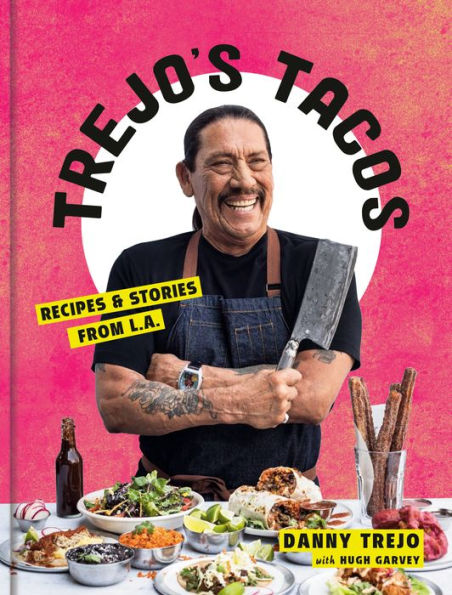Food and memory are tightly intertwined, and these recipes are a great start to reminisce about your favorite places through food or create memories with new recipes from around the world. Spanning the globe with these venerated cookbooks, we cannot wait to help you travel without leaving your kitchen through these delicious foods!
Hollywood’s baddest good guy shares 75 recipes that make Trejo’s Tacos the Los Angeles go-to for award-winning tacos, donuts, and more.
Long before he was a Hollywood star, Danny Trejo used to joke with his mom that they should open a restaurant. A few arrests, a couple boxing championships, and more than 300 movies later, Hollywood’s favorite bad guy did just that with Trejo’s Tacos. His unexpected journey from ex-con to actor to Narcotics Anonymous/Alcoholics Anonymous counselor to successful restaurateur is a true rags-to-riches story.
Now, in Trejo’s Tacos, Trejo not only shares 75 recipes for cantina favorites like succulent carnitas, vegan cauliflower tacos, and pillowy-sweet cinnamon-sugar lowrider donuts, but offers insights into his life and pays respect to his hometown, his roots, and all of the colorful characters who helped him along the way, creating a delicious tribute to L.A. and the city’s vibrant Latino culture.
1132922699
Long before he was a Hollywood star, Danny Trejo used to joke with his mom that they should open a restaurant. A few arrests, a couple boxing championships, and more than 300 movies later, Hollywood’s favorite bad guy did just that with Trejo’s Tacos. His unexpected journey from ex-con to actor to Narcotics Anonymous/Alcoholics Anonymous counselor to successful restaurateur is a true rags-to-riches story.
Now, in Trejo’s Tacos, Trejo not only shares 75 recipes for cantina favorites like succulent carnitas, vegan cauliflower tacos, and pillowy-sweet cinnamon-sugar lowrider donuts, but offers insights into his life and pays respect to his hometown, his roots, and all of the colorful characters who helped him along the way, creating a delicious tribute to L.A. and the city’s vibrant Latino culture.
Trejo's Tacos: Recipes and Stories from L.A.
Hollywood’s baddest good guy shares 75 recipes that make Trejo’s Tacos the Los Angeles go-to for award-winning tacos, donuts, and more.
Long before he was a Hollywood star, Danny Trejo used to joke with his mom that they should open a restaurant. A few arrests, a couple boxing championships, and more than 300 movies later, Hollywood’s favorite bad guy did just that with Trejo’s Tacos. His unexpected journey from ex-con to actor to Narcotics Anonymous/Alcoholics Anonymous counselor to successful restaurateur is a true rags-to-riches story.
Now, in Trejo’s Tacos, Trejo not only shares 75 recipes for cantina favorites like succulent carnitas, vegan cauliflower tacos, and pillowy-sweet cinnamon-sugar lowrider donuts, but offers insights into his life and pays respect to his hometown, his roots, and all of the colorful characters who helped him along the way, creating a delicious tribute to L.A. and the city’s vibrant Latino culture.
Long before he was a Hollywood star, Danny Trejo used to joke with his mom that they should open a restaurant. A few arrests, a couple boxing championships, and more than 300 movies later, Hollywood’s favorite bad guy did just that with Trejo’s Tacos. His unexpected journey from ex-con to actor to Narcotics Anonymous/Alcoholics Anonymous counselor to successful restaurateur is a true rags-to-riches story.
Now, in Trejo’s Tacos, Trejo not only shares 75 recipes for cantina favorites like succulent carnitas, vegan cauliflower tacos, and pillowy-sweet cinnamon-sugar lowrider donuts, but offers insights into his life and pays respect to his hometown, his roots, and all of the colorful characters who helped him along the way, creating a delicious tribute to L.A. and the city’s vibrant Latino culture.
6.99
In Stock
5
1

Trejo's Tacos: Recipes and Stories from L.A.
224
Trejo's Tacos: Recipes and Stories from L.A.
224Related collections and offers
6.99
In Stock

Product Details
| ISBN-13: | 9781984826862 |
|---|---|
| Publisher: | Clarkson Potter/Ten Speed |
| Publication date: | 04/21/2020 |
| Sold by: | Random House |
| Format: | eBook |
| Pages: | 224 |
| Sales rank: | 917,630 |
| File size: | 27 MB |
| Note: | This product may take a few minutes to download. |
About the Author
From the B&N Reads Blog
